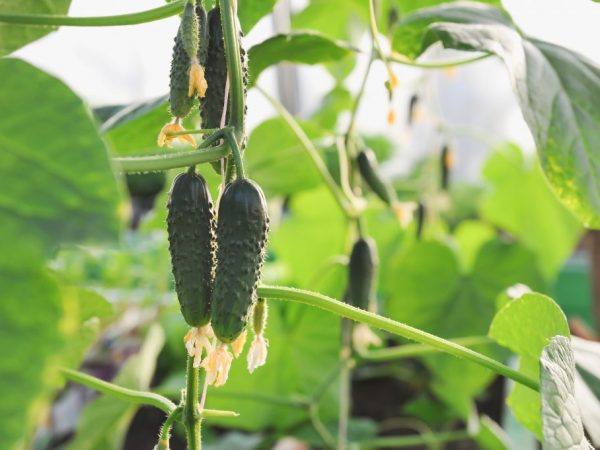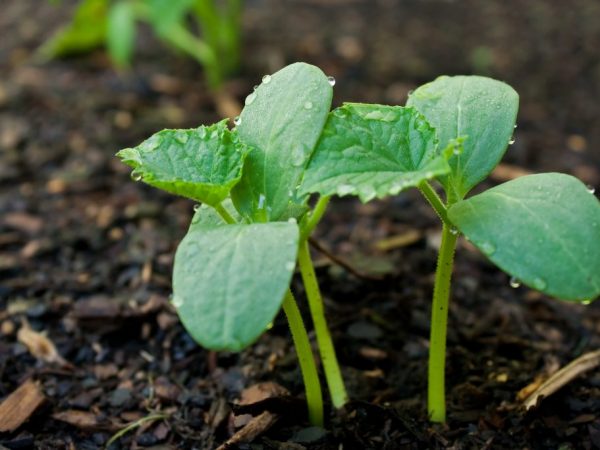Characteristics of cucumber varieties Everyone envy
Among the hybrid varieties, cucumbers to Everyone's Envy were recognized by summer residents as a very prolific, but capricious culture. Growing it, people sometimes get an unexpected result - low yield. The reason is usually the wrong formation of the shoots. Otherwise, she is quite unpretentious, and with minimal effort she will reveal herself well.

Characteristics of cucumber varieties Everyone envy
Characteristics of the variety
Cucumber f1 for All Envy quickly gives side shoots, their growth is intensive. It does not need pollinating insects for reproduction. Bunch flowering, in each such bunch 3-6 zelents can be tied. On average, they grow up to 9-12 cm.
The fruits are dark green in color, the shape is like a spindle. The surface of the cucumbers is even, and the thorns with stripes are white. They have an excellent presentation and excellent taste.
Dignity
The variety is quite realistic to grow as a home culture. This is due to the fact that he pollinates on his own, and is unpretentious to a lack of light. As for the rest of the strengths, there are a few points worth highlighting:
- ripens quickly;
- the harvest is plentiful, actively bears fruit until the first frost;
- complex resistance to diseases: mosaic virus, olive spot, powdery mildew. In addition, the cultivar is tolerant to root rot and downy mildew;
- continues to produce crops in conditions of lack of light;
- great for preservation and sourdough. And if you follow the cultivation technology, they are ideal for salads, since they will not taste bitter;
- well stored, tolerates transportation.
disadvantages
Among the shortcomings, one can single out the requirement of the variety for the strict formation of growth. But this can hardly be called a significant disadvantage, it will pay off with a good harvest. But the hybrid remains vulnerable to some diseases, like other cucumbers. For example, to fusarium wilting, gray and white rot.
Growing seeds
Cucumber seeds can be grown immediately by sowing in a permanent place. But the option with seedlings is more interesting, it gives a crop earlier, so we will consider it. To get strong and healthy shoots, cucumbers are sown at the end of March, or at the very beginning of April.
The seeds are immersed 1.5-2 cm into the soil of special cups, it will be very convenient for you in the future if they are biodegradable.
For good growth, a temperature of 25 degrees is needed, and the soil must be warmed up to 14-15 degrees. Until the sprouts have sprouted, they need to be covered with a protective material like a plastic wrap.
It is better to place seedlings by a window that faces south or southeast, so that there is enough sunlight for it. At the same time, cucumbers are first shaded so that aggressive sun rays do not burn tender seedlings. A good place would be a loggia or balcony, which should be insulated. Plants need light for 15-16 hours; their lack is supplemented with fluorescent lamps.
Soil preparation and greenhouses
To achieve high yields, equip a warm, multi-layer bed.For this, in the fall, a sunny place is selected on the site. The next step is to lay drainage, brushwood, branches, grass, straw, etc. are suitable for it. They are placed to a depth of 30-50 cm, after which they are well tamped. Fresh manure is put on top and left until spring, during the winter it will all settle.
From the beginning of May, the top is covered with a layer of fertile soil, but humus will show itself better than it.
Then a greenhouse is built, which is covered with a film, and after a few days it will be possible to proceed to planting. The preparation of such a soil is good in that the manure, during a burnout, heats the ground, providing cucumbers with the heat necessary for highly productive growth. In addition, such a base is rich in nutrients and will serve as a good source of all the necessary substances for the development of a vegetable culture.
You can also prepare a greenhouse in spring. Manure is placed on the drainage, and on top, 1 sq. m. scatter a mixture of wood ash (3 glasses) and nirofoski (100 gr.). The soil is laid on top, covered with a film and pressed with a load, and kept for one week. After that, you can start planting.
Landing

You can only plant seedlings with three real leaves.
Transfer to the greenhouse takes place in the last days of March, or early April. The readiness of the cucumbers is determined by the number of leaves, there should be 3-4 real leaves, and the antennae in the amount of 1-2 pieces. To give the plants the correct shape, the cucumber variety for Everyone To Envy is placed rather rarely, with a scheme of 60 x 15 cm. Otherwise, the yield may suffer.
Moisten the soil before planting, then dig holes the size of a seedling pot. For fertilization, 1 liter is used. solution Effekton-O for each well. Proportion: 3 tbsp. l. 10 liters. water, which should be warm. The next step is to plant seedlings there, they try not to fall asleep much from the pot.
Care
Watering f1 hybrid cucumbers should be at least three times a week, this has a good effect on their yield. Also, an even more important point will be to give the plant the correct shape: it is formed into a single stem, this improves its lighting and nutrition of the cucumber ovaries. 3-4 lower nodes blind, and all shoots that are higher are removed completely.
All nodes that are on the main stem must have one leaf and a tuft of ovaries. With the first harvest of zelents on the main stem, the crop is fed with complex and nitrogen fertilizer. In the future, feeding should be weekly, its timeliness contributes to new cucumber ovaries.
Pest control
The description says that f1 hybrid varieties are very resistant to pests, therefore, environmentally friendly products can be used. For prevention, you can insist the tops of nightshades or onions with garlic, and then spray the plants with them. However, in neglected situations, more specific things should help.
Tincture of red pepper with tobacco dust will help get rid of melon aphids.
They make it in hot water, about 60 degrees, placing it in 10 liters. 30 g of pepper and 200 g of tobacco dust, the infusion will be ready in a day. Then add wood ash and liquid soap, 2 tbsp each. l. everyone.
The whole plant is sprayed with the resulting composition, to consolidate the result, the treatment is repeated after a week. The description of the solution for combating spider mites is the same as for aphids. In the fight against whitefly, careful cleaning of plant debris and placement of traps will help. They are made from a piece of plywood covered with white paint, and an adhesive is applied on top. The white color will attract butterflies to the trap, then they are disposed of and the trap is renewed.
Treatment of diseases
Fusarium wilting - control of moisture levels is the best prevention. The bacteria that cause this disease develop well when moisture is abundant. To prevent the disease, the seeds are treated before sowing and regularly get rid of debris during cultivation. For disinfection, the soil is treated with Fitosporin or Trichoderin, a week before planting.Good compost will also help improve the health of the soil.
Gray rot - has a fungal nature, it can be provoked by watering the plant with cold water.
If trouble does happen, you need to refrain from watering for 2-3 days, the greenhouse is ventilated, the excess parts of the plants are cut off, and the rest are stirred so that they are better ventilated. Places of cuts are powdered with copper-chalk powder, or treated with a mixture of ash and chalk (1 glass each) and copper sulfate (1 tbsp. L.).
White rot - like gray, occurs due to overmoistening of the air and soil. For protection, it is important to observe crop rotation, remove plant residues from the beds. In case of infection, the damaged parts of the plant are disposed of, the sections are treated with lime, charcoal, or a mixture of chalk and sulfuric acid 1 to 1.
Conclusion
A prolific and resilient cucumber cultivar for everyone to envy, it will be a good option for greenhouse cultivation. Experiment lovers can grow them at home, they are not very demanding on light. Zelentsy tolerate transportation well, are good for pickles, and with proper care they will not taste bitter at all. Take care of this variety: cut side shoots in time, do regular feeding, and it will repay with a wonderful harvest.


